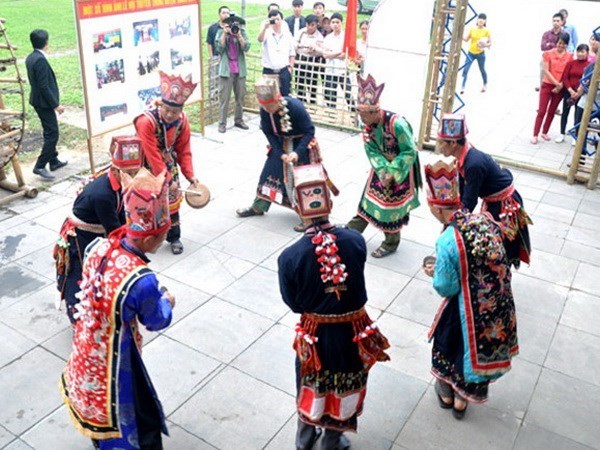
Bestowed with an array of world and national cultural heritages, the northern midland province of Phu Tho is looking for breakthrough measures to capitalise on its strength to become a must-visit destination for both domestic and international tourists.

At a cultural camp in Phu Tho (Source: VNA)
According to the provincial Department of Culture, Sports and
Tourism, the province is currently home to 1,372 historical and cultural sites,
including Hung Kings Temple special relic site, and three UNESCO intangible
cultural heritages of the worshipping rituals of the Hung Kings, Xoan folk
singing, and ca tru-ceremonial singing.
Xuan Son National Park, which boasts diverse ecosystems, untouched natural
beauty, and cultural identities of ethnic people, is a fascinating tourism
magnet. It is among 13 national parks in Vietnam that protect large habitats of
natural ecosystems.
In addition, Thanh Thuy hot mineral water mine, Tam Giang pagoda, Mother Au Co
Temple, and Ao Chau lagoon all together create conditions for the province to
branch out various kinds of tourism products like eco-tourism,
historical-cultural tourism, and resort tourism.
Grasping local tourism potential, the tourism sector integrated the "Xoan
singing in ancient village” into its cultural heritage tours, and the outcomes
were incredible as to local tourism destinations like Hung Lo communal house
and Lai Len shrine in Viet Tri city, Do Nghia communal house in Lam Thao
district has become popular to domestic and foreign visitors.
Besides ancient Xoan singing, visitors will have a chance to have a look at
historical and cultural relic sites built during the time of Hung Kings.
Director of the province’s centre for tourism promotion Phung Thi Hoa Le said
that thanks to the availability of the tours, more tourists are coming to the
locality. The centre welcomes an average 2 million visitors each year, nearly
8,000 of them come to explore the Vietnamese folk music.
Various travel companies have developed tours featuring Xoan singing like
Vietrantour, Saigontourist and Golden tour, she said.
The centre also designs new tourism products to attract more tourists and
introduce to travel agencies. Now, Gia Thanh conical hat village in Phu Ninh
district, Dich Qua tea hills in Thanh Son district, Tam Giang temple in Viet
Tri city, Dao Xa communal house in Thanh Thuy district and Du Yen temple are
ready to welcome tourists.
In addition, the province is working to promote products linking local tourism
sites like Hung King Temple-Hung Vuong Museum-Hung Lo communal house in Viet
Tri city, Xuan Son National Park-Thanh Thuy hot mineral water spring, and
Mother Au Co temple- Ao Chau lagoon tourism site. It has joined hands with
neighbouring provinces of Lao Cai and Yen Bai to branch out spiritual tours
along Hong River.
Signing cooperation programmes with foreign travel companies in the Republic of
Korea, Indonesia and India, and partnership in tourism programmes with
localities across the country are significant moves to popularize local tourism
sites.
This year, the tourism sector of the province eyes to welcome 580,000 visitors,
up 5.4 percent from the yearly plan, and expects to earn 3.8 trillion VND
(159.6 million USD).
Source: VNA
A diverse chain of eco-tourism and resort destinations concentrated in Hoa Binh city and the districts of Tan Lac, Da Bac, and Luong Son… Along with the launch of several key high-quality resort tourism projects, these developments have reshaped the landscape and enhanced the appeal of Hoa Binh as a travel destination.
Boasting diverse terrain, a mild climate, and rich natural resources, Cao Phong district is increasingly asserting its place on Vietnam’s tourism map, attracting both domestic and foreign visitors. The district is renowned for its stunning landscapes, majestic mountains, a crystal-clear hydropower lake, and the unique cultural identity of local ethnic groups.
With its pristine landscapes, unique cultural heritage of Muong ethnic minority, and an expanding range of visitor experiences, Tan Lac district of Hoa Binh has fast become a captivating destination for both domestic and international tourists.
Until now, Sung village in Cao Son commune, Da Bac district remains the only Dao ethnic community in Hoa Binh province to develop a community-based tourism model. Beyond its untouched natural landscapes, cultural identity serves as the cornerstone attraction for visitors.
Alongside the diverse cultural identities of the Kinh, Muong, Tay, Thai, Dao, and Mong ethnic people, Hoa Binh province is also renowned as the "capital" of the northwestern Vietnamese cuisine, offering unique and distinctive dishes. At festivals, during Lunar New Year (Tet), or on significant family or community occasions, special dishes are prepared, leaving a lasting impression on visitors.
A Phong Linh (Yellow Tabebuia) flower garden in Thang village, Thach Yen commune, Cao Phong district is currently in full bloom, drawing a large number of visitors.



